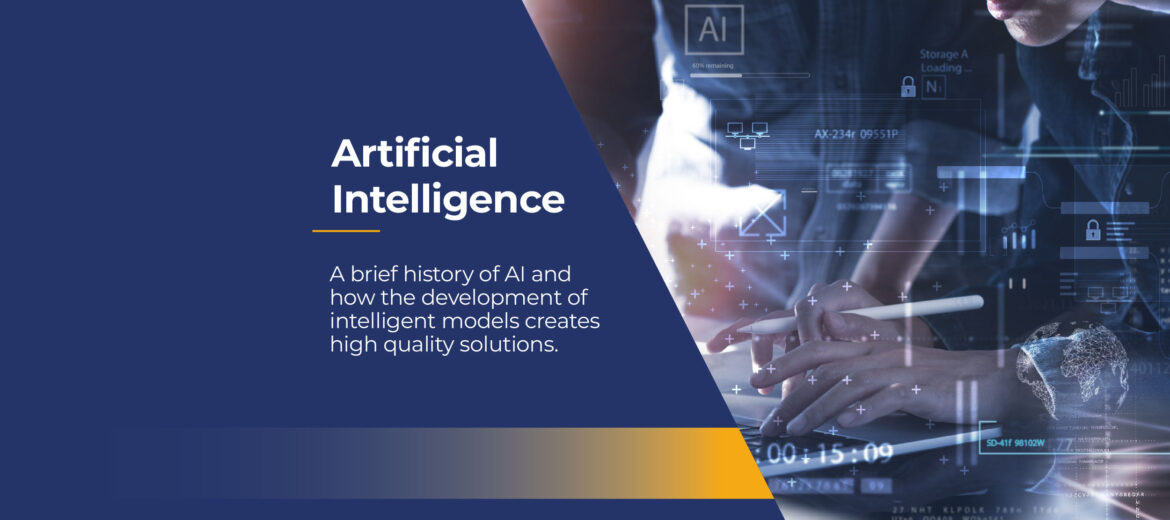Artificial Intelligence (AI) has ceased to be an unknown and has become an integral part of our daily interactions with each other and the devices surrounding us. From antiquity to the 20th century, from Greek philosophers to Turing and McCarthy, we now have models capable of generating photorealistic images and multiple industrial applications. This is a brief introduction to AI and how Aplicaciones Tecnológicas’s AI department is specialised in the creation of trained models in constant evolution to achieve the #fficiency of its solutions which, in addition, can be adapted to the needs of any client.
Artificial Intelligence, also known by its abbreviation (AI), is a field of study that seeks to develop computer systems and algorithms that exhibit specific human-like capabilities. The origins of what we know today as AI date back to the 1940s, when scientists began to investigate the possibility of creating machines capable of learning and reasoning, ideas that previously only had room for speculation.
The original concept of Artificial Intelligence dates back to antiquity and the philosophical reflection on the nature of intelligence and the possibility of mechanisation of human thought. It was at that time that the first myths about automata (machines that imitate the figure and movements of an animate being) appeared, such as the giant Talos, the proto-Android defender of Crete.[1]
The depiction of artificial intelligence in fiction has been a source of inspiration and reflection since its inception. Authors such as Isaac Asimov imagined worlds populated by robots with ethical laws embedded in their programming, while works such as Arthur C. Clarke’s 2001: A Space Odyssey explored the interaction between humans and a form of artificial intelligence called HAL 9000. These literary and cinematic works helped shape public perception of AI and raised fundamental questions about ethics and coexistence between humans and machines.
One of the first milestones in the development of AI was the work of British mathematician Alan Turing. In 1950 he published a paper entitled Computing Machinery and Intelligence [2] in which he posed the question. “Can machines think?” and proposed the Turing Test, a method for determining, through questions, the ability of a machine to exhibit intelligent behaviour similar to that of a human being. The legacy of Turing’s ideas continues to this day, a reverse version of that test called the Completely Automated Public Turing test to tell Computers and Humans Apart (CAPTCHA) is used daily as a security measure to discern whether a human or a machine is trying to access a system.
Later, in 1956, John McCarthy, Marvin Minsky, Claude Shannon and other scientists organised the Dartmouth Conference on Artificial Intelligence, the conclusions of which gave birth to the term we are all familiar with. This conference is considered to be the starting point of modern AI.[3]
Over the next decades, AI has made great progress. Today, it is used in a wide range of applications, from medicine to industry, and has entered our everyday lives via generative text and image models such as ChatGPT. In the industrial context, AI is used to automate tasks, improve efficiency and productivity, and make more informed decisions.
Inside Artificial Intelligence: learning to evolve
Machine Learning (ML) is a field of AI specialising in algorithms and techniques that allow machines to learn from data and improve their performance based on experience. Within ML, Deep Learning focuses on algorithms based on deep neural networks, which are built as an analogy to the human brain.
The AI department of Aplicaciones Tecnológicas S.A. develops customised models and tools based on AI to solve problems related to data from various sources, such as the medical or energy sector, applying these systems and algorithms with a clear objective: to digitise processes to deliver high-quality solutions, capable of evolving and optimising any system.
The growing ability of AI to recognise patterns through the data collected by sensors allows, for example, the status of an electrical infrastructure to be checked in real-time for malfunctions, both in the installation itself and in the assets connected to it.
How does an AI model work?
The operation of Artificial Intelligence models is based on the interpretation of large amounts of data. However, these units of information, by themselves, are useless if they are not processed.
For example, in supervised learning, for a model to learn to recognise patterns and relationships in the information it receives, it needs to be provided with a set of labelled data that allows it to understand the desired outcome. This means that it needs to know what the correct response is for each input, to adjust its parameters, improve its accuracy over time, and interpret that data in a way that provides useful information.
Aplicaciones Tecnológica’s intelligent sensing solutions collect the raw data and transform it, through a trained model, into useful information for the customer. This makes it possible to optimise processes and detect anomalies as they occur.
What are its applications?
An artificial intelligence (AI) model, such as the one developed by Aplicaciones Tecnológicas S.A., opens up a limitless horizon for achieving the efficiency of an earthing system, both of the system itself and of any connected element.
AI and machine learning can automatically detect any anomaly and signal it in real-time to carry out corrective maintenance as quickly as possible and in the event of any eventuality (theft of material, malfunctioning of equipment, etc.).
In this way, companies protect their assets, reduce energy waste resulting from a failure and save costs. In addition, through pattern recognition, and based on the data it records, it can also predict when preventive maintenance actions will be necessary to avoid critical situations.
In addition, as an outsourcing company, we specialise in providing customised Smart Digital Ecosystems solutions to our customers, enabling them to outsource their data analytics and artificial intelligence needs. This helps them to focus on their core activities and reduce costs while benefiting from our expertise and technical skills in the development and implementation of AI-based solutions.
[1] Mayor, Adrienne. Gods and Robots: Myths, Machines, and Ancient Dreams of Technology (Princeton University Press, 2018)
[2] Turing, A.M. Computing Machinery and Intelligence. Mind, Volume LIX, Number 236, October 1950, Pages 433–460.
[3] Artificial Intelligence Coined at Dartmouth. (Dartmouth Milestones website)



